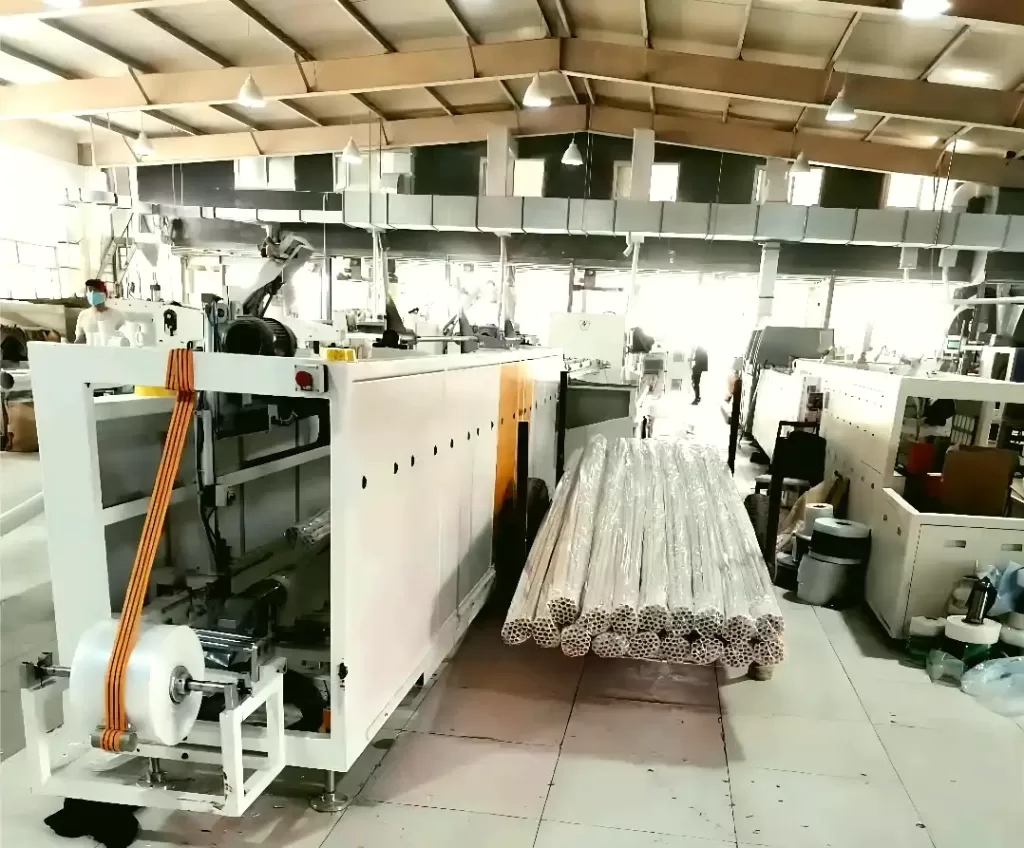Optimizing Pipe Handling: A Guide to Pipe Wrapping and Bundling Machines
Efficient handling and protection of pipes are crucial in fabrication, manufacturing, and distribution. Damage during transit or storage can lead to significant costs and project delays. Pipe wrapping and bundling machines offer automated solutions to streamline these processes, ensuring pipes reach their destination securely and in optimal condition. This guide explores the functions, benefits, and considerations surrounding these essential pieces of equipment.
Understanding Pipe Wrapping Machines
A pipe wrapping machine is specialized equipment designed to apply a protective layer of material, such as stretch film, VCI (Volatile Corrosion Inhibitor) film, or paper, around individual pipes or pipe bundles.
How They Work:
Most commonly, these machines utilize an orbital wrapping process. The pipe is fed horizontally through a rotating ring that dispenses the wrapping material. This ensures consistent overlap and tension, creating a tight, protective cocoon around the pipe's surface.
Key Benefits:
- Surface Protection: Shields pipes from scratches, dirt, moisture, and environmental contaminants during handling and storage.
- Corrosion Prevention: When using materials like VCI film, it actively prevents rust and corrosion, particularly important for metal pipes.
- Improved Handling: Wrapped pipes or bundles can sometimes be easier and safer to handle.
- Enhanced Appearance: Provides a clean, professional look for finished products.
Common Wrapping Materials:
- Stretch Film (LLDPE): Offers good load retention, puncture resistance, and protection against dirt and moisture.
- VCI Film: Impregnated with chemicals that vaporize and condense on metal surfaces to prevent corrosion.
- Paper/Kraft Paper: Provides basic protection and can be used for specific applications or as an interleaving layer.

online pipe bundling ang bagging machine2 Exploring Pipe Bundling Machines
Pipe bundling machines are used to group multiple pipes together into a single, manageable unit, often securing them with straps or bands, or sometimes by wrapping the entire bundle. This simplifies handling, storage, and transportation.
How They Work:
These systems typically gather a pre-set number of pipes, align them, and then automatically apply strapping (usually steel or PET) at designated intervals along the bundle's length. Some systems may integrate wrapping after strapping for further protection and unitization. They can operate inline with production or offline as standalone stations.
Key Benefits:
- Unitization: Creates stable, consolidated units, simplifying loading, unloading, and inventory management.
- Reduced Labor: Automates the often labor-intensive process of manually bundling pipes.
- Improved Safety: Minimizes manual handling of individual heavy pipes, reducing injury risks.
- Space Optimization: Bundled pipes often occupy storage space more efficiently than loose pipes.
Watch an Automatic Offline Pipe Bundling and Bagging Machine in Action
The video below demonstrates an example of an automatic offline system that combines pipe bundling and subsequent bagging for enhanced protection.
Key Considerations When Selecting Equipment
Choosing the right pipe wrapping or bundling machine requires careful evaluation of specific operational needs:
- Pipe Specifications: Consider the range of diameters, lengths, weights, and pipe materials (e.g., steel, plastic, copper) to be handled.
- Throughput Requirements: Match the machine's speed and capacity (pipes or bundles per hour) to your production output.
- Level of Automation: Determine the need for fully automatic inline systems versus semi-automatic or offline solutions.
- Wrapping/Bundling Materials: Ensure compatibility with required protective materials (film type, strap type, etc.).
- Bundle Configuration: Define the desired bundle shapes (e.g., hexagonal, square) and sizes.
- Integration: Assess how the machine will fit into your existing workflow and facility layout. Consider integration with upstream and downstream processes or plant control systems.
- Operating Environment: Factor in space constraints, power availability, and environmental conditions.

automatic pipe bagging machine for pvc and ppr Conclusion
Pipe wrapping and bundling machines are invaluable assets for any operation dealing with the manufacture or distribution of pipes. By automating protection and unitization processes, they contribute significantly to operational efficiency, product quality preservation, enhanced safety, and reduced labor costs. Carefully selecting equipment based on specific application requirements ensures maximum return on investment and optimized pipe handling throughout the supply chain.